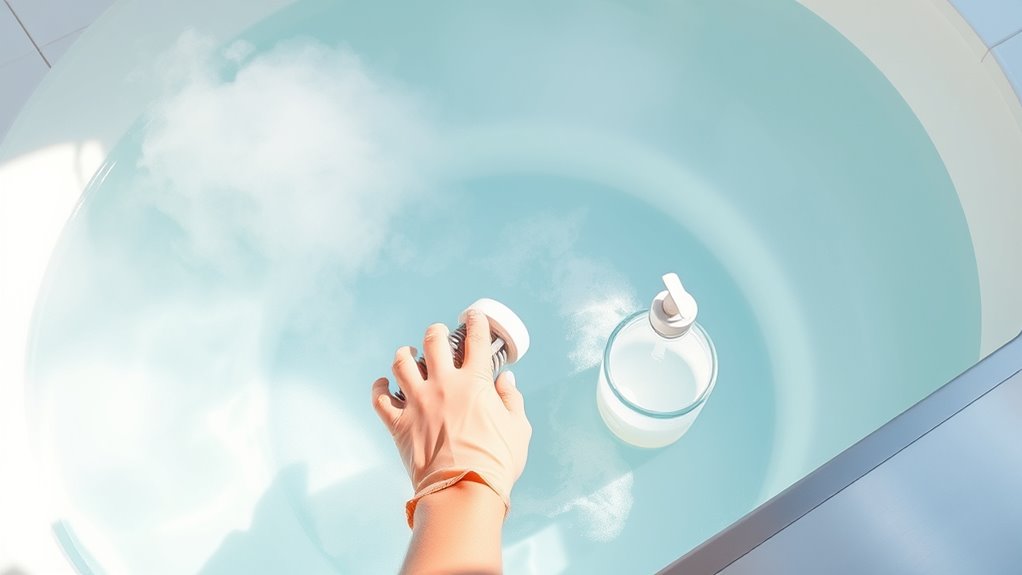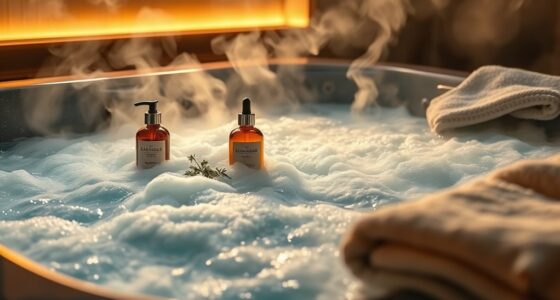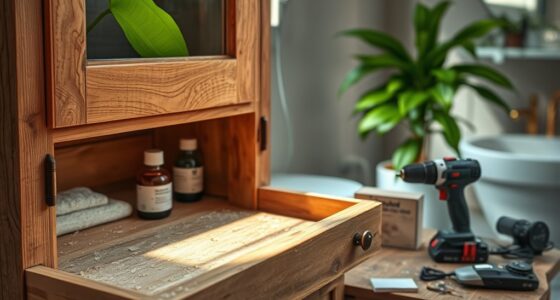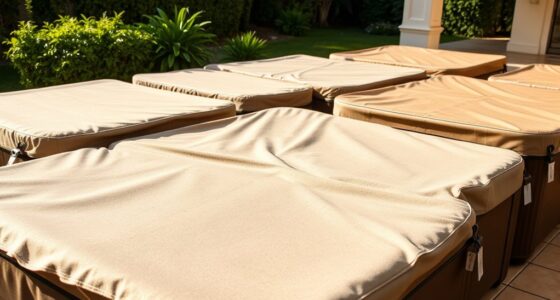To clean your hot tub, start by gathering supplies like gentle cleaners, a sponge, scrub brush, and test strips. Drain old water completely, then inspect and clean the shell with non-abrasive products. Rinse and dry surfaces thoroughly, then clean or replace the filters. Refill with fresh water, balancing pH and sanitizer levels carefully. Regular maintenance, including water testing and debris removal, helps keep your hot tub pristine and ready for use. For detailed tips, continue exploring these essential steps.
Key Takeaways
- Drain the hot tub completely, clean the shell with non-abrasive cleaners, and rinse thoroughly.
- Refill with fresh water and balance water chemistry by testing pH, alkalinity, and calcium hardness.
- Remove and clean filters by rinsing and soaking in a gentle cleaning solution before reinstalling.
- Inspect and remove debris from surfaces and shell using soft tools, then rinse and dry thoroughly.
- Regularly check chemical levels and maintain proper sanitizer levels to keep the water clean and safe.
Gathering the Necessary Supplies and Tools
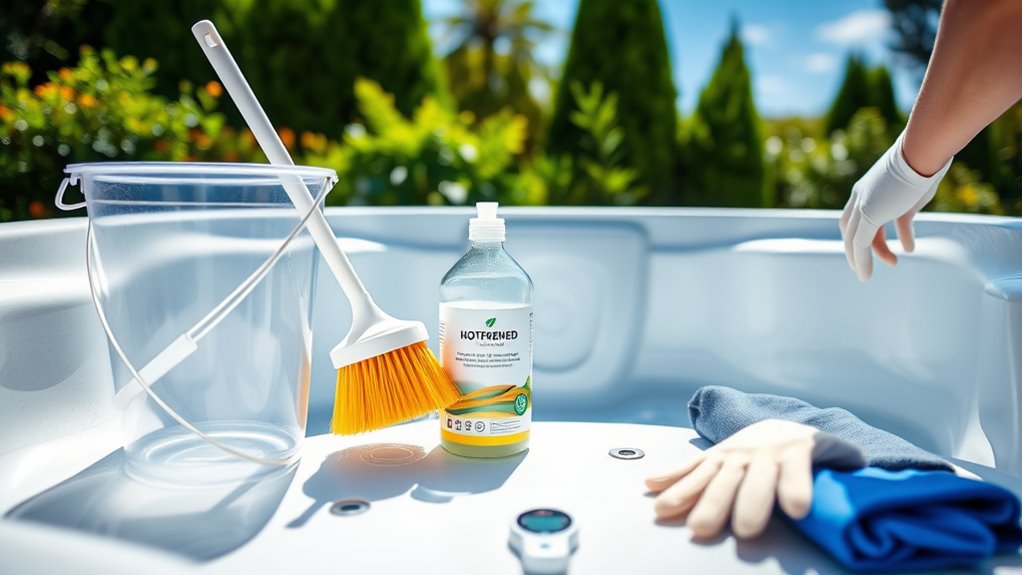
Before you begin cleaning your hot tub, it’s essential to gather all the supplies and tools you’ll need. Start with a gentle spa or hot tub cleaner to remove dirt and grime without damaging the surface. You’ll also need a soft sponge or microfiber cloth to wipe down the shell. A scrub brush can help reach stubborn spots, while a plastic or rubber scraper is handy for removing any buildup. Don’t forget a garden hose with a spray nozzle for rinsing, along with towels or rags for drying. If you plan to drain the water, have a suitable bucket or siphon ready. Keep gloves and goggles nearby for safety, and consider a test strip kit for checking water chemistry later. Being prepared ensures a smooth, effective cleaning process. Additionally, understanding water chemistry is crucial for maintaining a clean and safe hot tub environment.
Testing and Balancing Water Chemistry

To keep your hot tub water safe and inviting, you need to check the pH and chlorine levels regularly. Testing these levels helps you understand what adjustments are necessary to maintain proper chemical balance. Once you have the results, you can add the right chemicals to keep your water clean and balanced. Using an appropriate testing kit ensures accurate readings and effective maintenance. Regular testing fosters a digital literacy that can help you troubleshoot issues more effectively. Being familiar with small mistakes in chemical testing can prevent larger problems down the line. Additionally, understanding how to interpret headphone compatibility can help you troubleshoot any audio issues that may arise during maintenance or setup. Staying informed about latest breakthroughs in machine learning tech can also improve your approach to smart home devices, including your hot tub system, making maintenance more efficient.
Check Water Ph Levels
Checking your hot tub’s water pH levels is a crucial step in maintaining balanced water chemistry. Proper pH ensures your water isn’t too acidic or alkaline, which can cause skin irritation and damage your equipment. To test the pH, use a reliable test strip or a liquid test kit. Dip the strip into the water or add a few drops of the testing solution, then compare the color change to the chart provided. Ideal pH levels range from 7.2 to 7.8. If your pH is too low, add a pH increaser; if it’s too high, add a pH reducer. Regularly checking and adjusting pH helps keep your hot tub safe, comfortable, and in top condition. Incorporating water chemistry management in your maintenance routine can help you monitor and optimize water quality effectively. Maintaining proper water chemistry can also prevent issues like bacterial growth and equipment corrosion, ensuring a safer hot tub experience. Additionally, monitoring your appliance integration can streamline maintenance tasks and improve overall water quality control.
Test for Chlorine Levels
Have you tested your hot tub’s chlorine levels recently? If not, it’s time to check them to confirm safe and clean water. Use a test strip or a liquid test kit designed for hot tubs. Dip the strip into the water or add a few drops of the reagent, then wait for the color to develop. Compare the result to the color chart provided. Ideally, your chlorine level should be between 3 and 5 ppm (parts per million). Low chlorine levels can lead to bacteria growth, while high levels may cause skin irritation. Regular testing helps you maintain proper sanitation and prevents issues down the line. Make testing a routine part of your hot tub maintenance to keep the water safe and enjoyable. Incorporating automated testing methods can further streamline your water quality monitoring process. Additionally, understanding the water chemistry helps you better manage sanitizer levels and maintain balance. Monitoring water pH regularly ensures optimal sanitizer effectiveness and overall water health. Maintaining proper sanitizer levels is essential for preventing microbial growth and ensuring a pleasant soaking experience.
Adjust Chemical Balance
Maintaining the proper chemical balance in your hot tub guarantees safe, comfortable soaking. To achieve this, you need to test and adjust your water chemistry regularly. Start by checking pH levels; they should be between 7.2 and 7.8. If the pH is too low, add a pH increaser; if it’s too high, use a pH decreaser. Next, monitor alkalinity, which helps stabilize pH; adjust as needed. Also, verify sanitizer levels like chlorine or bromine to keep bacteria at bay. Keep an eye on calcium hardness to prevent scaling or corrosion. Proper use of test strips makes this process more accurate and efficient. Regular testing ensures your filtration system functions optimally and prolongs the life of your hot tub components. Consistently monitoring water chemistry is essential for preventing scale buildup and maintaining water clarity. Additionally, understanding home security can help protect your hot tub from theft or vandalism, especially when it’s not in use. Remember that water chemistry directly impacts the overall health and enjoyment of your hot tub experience.
Draining and Removing Old Water
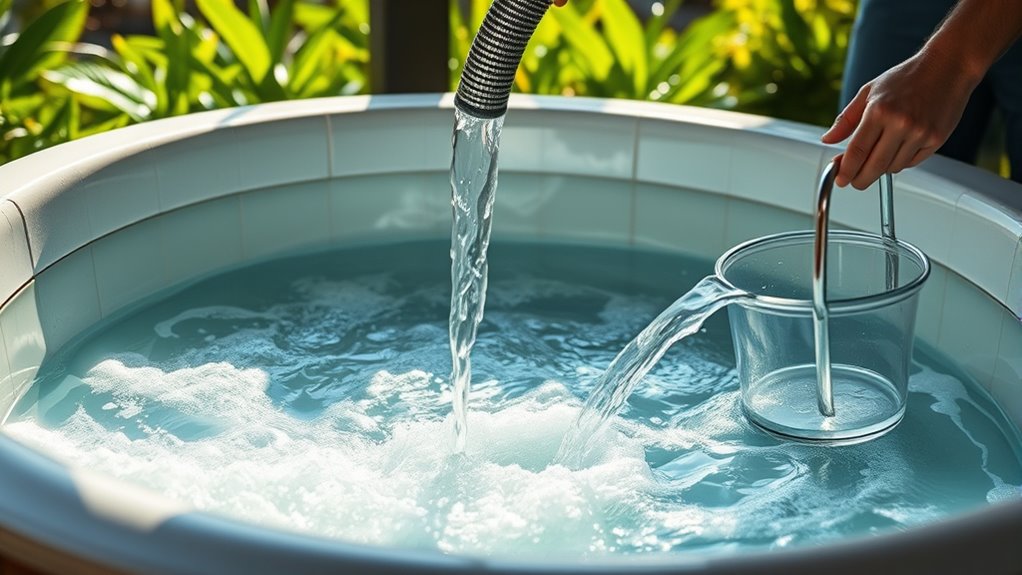
Before you begin cleaning your hot tub, it’s essential to drain the old water completely. Turn off the power and disconnect the hot tub from its power source for safety. Locate the drain valve or plug, usually found at the bottom of the tub, and open it to release the water. If your hot tub doesn’t have a drain valve, you may need to use a sump pump or a wet/dry vacuum to remove the water. Make sure to direct the water into a suitable drain or outside in a safe area. Removing all the old water ensures that you won’t have leftover residues or contaminants, paving the way for a thorough cleaning and fresh fill. Additionally, understanding the different cookie categories can help you maintain privacy and security while browsing during your cleaning process. Using a self watering plant pot can be a convenient way to keep your plants healthy while you focus on other chores.
Cleaning the Hot Tub Surface and Shell
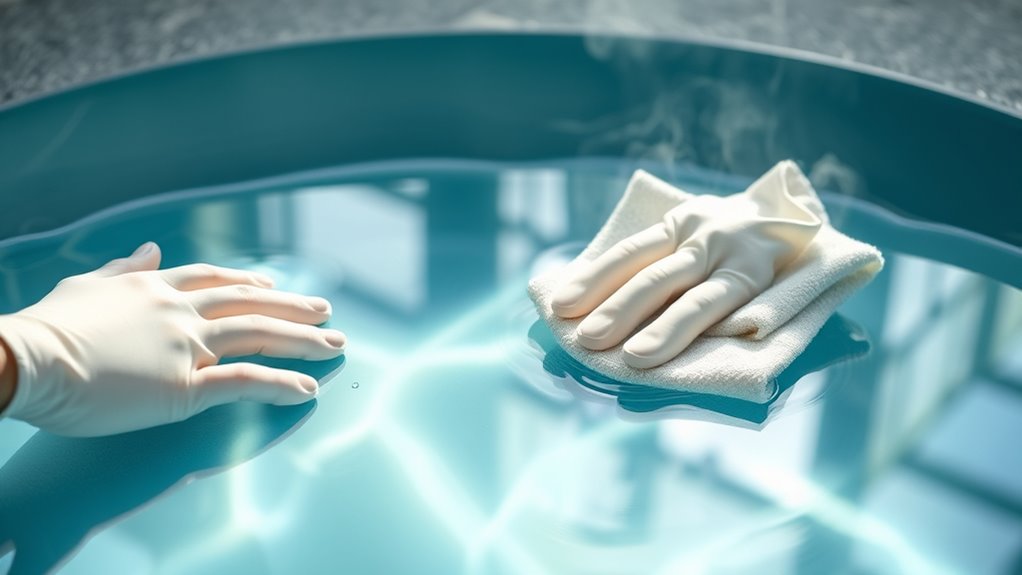
Start by removing any debris and dirt from the surface and shell of your hot tub. Use the right cleaning products to safely break down grime without damaging the surface. After cleaning, rinse thoroughly and dry the shell completely to prevent water spots and buildup.
Remove Debris and Dirt
To effectively remove debris and dirt from your hot tub, begin by inspecting the surface and shell for leaves, bugs, or other particles that may have settled. Use a skimmer net or soft cloth to gently lift debris from the water and sides. Focus on areas where dirt tends to accumulate, like corners and around jets. Regularly cleaning these spots prevents buildup and keeps the water clear.
- Skim floating debris with a net
- Wipe down surfaces with a microfiber cloth
- Remove dirt from jets and crevices
- Check and clean the filter area
- Rinse the shell with a gentle spray
Staying proactive with debris removal helps maintain a clean, inviting hot tub.
Use Appropriate Cleaning Products
After removing debris and dirt, it’s important to choose the right cleaning products to maintain the hot tub’s surface and shell. Use a gentle, non-abrasive cleaner specifically designed for hot tubs or acrylic surfaces. Avoid harsh chemicals like bleach or ammonia, as they can damage the shell and degrade the surface over time. Instead, opt for a pH-balanced cleaner that effectively removes oils, lotions, and dirt without harming the material. Always read labels carefully to ensure the product is safe for hot tubs. Test any new cleaner on a small, hidden area first to prevent discoloration or damage. Using the proper cleaning products will help keep your hot tub looking new and functioning properly.
Rinse and Dry Thoroughly
Once you’ve applied your chosen cleaning products, it’s crucial to rinse the surface thoroughly to remove any residue. Use a clean, damp cloth or sponge to wipe down the entire shell and surface, making certain all cleaning agents are rinsed away. Pay special attention to seams, corners, and hard-to-reach spots where dirt and residue can hide. After rinsing, dry the surface completely with a soft towel to prevent water spots and mold growth. Proper drying helps maintain the hot tub’s surface and prevents moisture buildup.
- Use a microfiber cloth for a streak-free finish
- Check for lingering soap or cleaner residues
- Focus on seams and edges during rinsing
- Dry with a clean, soft towel
- Make sure no water remains before closing the cover
Cleaning the Filters Thoroughly
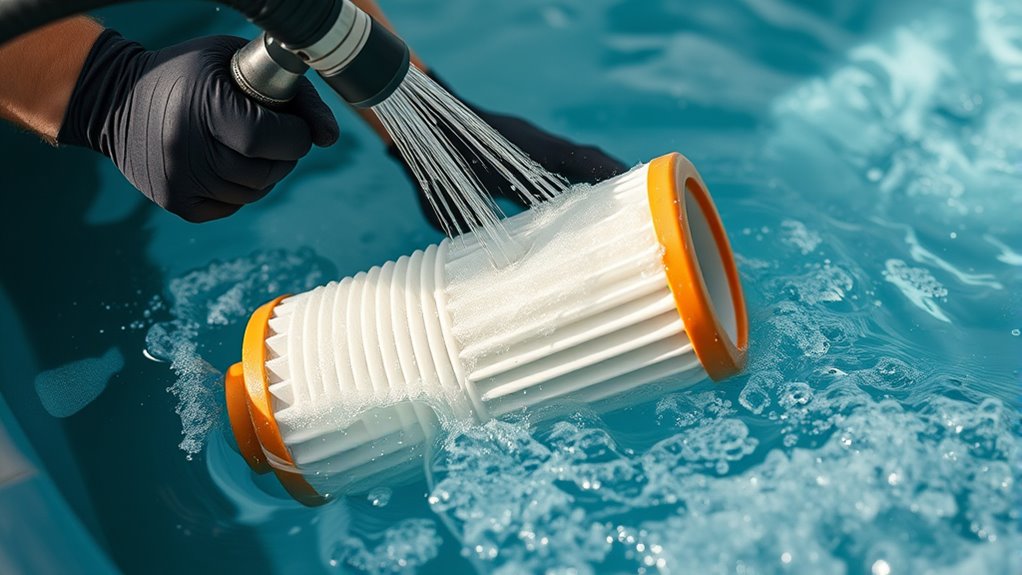
Cleaning your hot tub filters thoroughly is essential to maintaining clear water and ideal performance. Start by removing the filters from your hot tub and rinsing off loose debris with a garden hose or sink sprayer. Next, soak the filters in a filter-cleaning solution or a mixture of water and a gentle cleaner designed for spa filters. Let them sit for at least 15-30 minutes to loosen dirt and oils. After soaking, scrub the pleats gently with a soft brush to remove stubborn grime. Rinse thoroughly to wash away any remaining residue. Verify the filters are completely dry before reinstalling. Regular cleaning prevents buildup and keeps your hot tub running smoothly, ensuring clean, healthy water each time you soak.
Refilling and Balancing New Water

Begin by draining the hot tub completely and removing any remaining debris or residue from the shell. Once empty, refill it with fresh water, making certain the water level covers the jets and filters properly. As you fill, check for leaks or drips around fittings. After filling, balance the water chemistry by testing pH, alkalinity, and calcium hardness. Add the necessary chemicals gradually, following the manufacturer’s instructions. Proper balancing helps prevent scale buildup and corrosion, guaranteeing safe, comfortable use. Remember to circulate the water thoroughly after adding chemicals. Here are key steps to focus on:
Drain, clean, refill, and balance your hot tub for safe, enjoyable use.
- Use a high-quality water test kit
- Adjust pH to 7.2–7.8
- Set alkalinity between 80–120 ppm
- Maintain calcium hardness around 150–250 ppm
- Add sanitizer as recommended
This process ensures your hot tub is prepared for safe, enjoyable use.
Maintaining Regular Hot Tub Care

To keep your hot tub safe and inviting, you should establish a regular maintenance routine. Check the water chemistry weekly, balancing pH, alkalinity, and sanitizer levels to prevent bacteria growth and keep water clear. Clean the filters every 1-2 months to ensure proper circulation and filtration. Drain and refill the hot tub every 3 to 4 months, or as needed, to remove buildup and maintain water quality. Wipe down the surfaces and check for any signs of wear or damage regularly. Keep the cover clean and conditioned to extend its lifespan. By staying consistent with these tasks, you’ll prevent issues before they start, prolong your hot tub’s life, and ensure every soak is safe, clean, and relaxing.
Frequently Asked Questions
How Often Should I Clean My Hot Tub in a Year?
You should clean your hot tub at least once a month to keep it in top shape. Regular cleaning prevents bacteria buildup, algae growth, and keeps the water sparkling. If you use it more frequently or notice dirt and debris, consider cleaning more often. Also, drain and refill the water every 3 to 4 months to maintain water quality. Consistent maintenance guarantees a safe, inviting hot tub experience.
Can I Use Household Cleaners on the Hot Tub Shell?
You wonder if household cleaners are safe for your hot tub shell. It’s best to avoid them, as many contain harsh chemicals that can damage the surface or leave residues. Instead, use a gentle, non-abrasive cleaner specifically designed for hot tubs or a mixture of mild soap and water. This way, you protect your tub’s shell while keeping it clean and shiny without risking any damage.
What Signs Indicate My Hot Tub Needs Professional Servicing?
Did you know that over 60% of hot tub owners overlook signs of needed professional service? If your jets are weak, water discoloration occurs, or you notice persistent foul smells, it’s time to call in a pro. These issues can signal underlying problems like bacterial buildup or equipment failure. Ignoring them risks costly repairs or health hazards. Regular inspections guarantee your hot tub remains safe, clean, and enjoyable.
How Do I Prevent Algae Buildup in My Hot Tub?
To prevent algae buildup in your hot tub, you should maintain proper water chemistry and circulation. Regularly test and balance your pH and sanitizer levels, ideally weekly. Run the jets daily to keep water moving, and clean the filter often. Cover your hot tub when not in use to block sunlight, which encourages algae growth. Consistent maintenance and monitoring will keep your hot tub clear and algae-free.
Is It Safe to Use Bleach in My Hot Tub?
Using bleach in your hot tub isn’t recommended because it can be harsh on the spa’s components and irritate your skin. Instead, opt for specialized hot tub cleaning products or sanitizers designed for safe use. Always follow the manufacturer’s instructions for water treatment and cleaning. Regular maintenance, like balancing pH levels and shocking the water, keeps your hot tub safe, clean, and enjoyable without risking damage or health issues.
Conclusion
Regular hot tub cleaning is essential for safe, enjoyable soaking. Did you know that neglected hot tubs can harbor bacteria and algae, increasing health risks by up to 70%? By following these simple steps, you ensure your hot tub stays clean and inviting. Consistent maintenance not only prolongs its lifespan but also keeps your relaxation safe. Make cleaning a routine, and you’ll always have a invigorating, worry-free hot tub experience.
